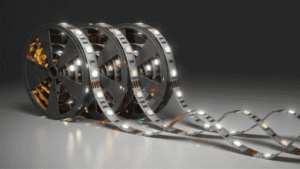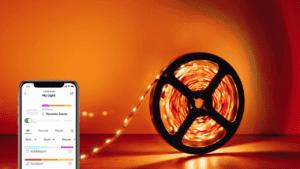
When it comes to architectural lighting and design installations, LED wall installation offer a versatile and impactful solution, combining the functionality of lighting with the creativity of visual displays.
LED walls provide a customizable and dynamic lighting experience, allowing architects and designers to transform spaces with eye-catching visuals, vibrant colors, and stunning effects. Therefore LED walls for enhancing architectural lighting and design installations can be a great choice!
This innovative technology is ideal for both interior and exterior applications, providing architects with the flexibility to enhance the aesthetics and atmosphere of any environment. LED walls are not only energy-efficient and long-lasting but also offer a wide range of design possibilities, making them a popular choice in the field of architectural lighting and design installations.
The Rise Of Led Walls In Architectural Lighting
LED walls are gaining popularity in architectural lighting and design installations. These versatile and energy-efficient solutions provide a dynamic and immersive experience, enhancing the aesthetics of any space.
LED technology has revolutionized the field of architectural lighting, bringing a new level of creativity and flexibility to designers and architects. Among the many applications of LED lighting, the use of LED walls in architectural spaces has seen a significant rise in recent years.
These large-scale displays offer a range of benefits and possibilities in enhancing the visual impact of diverse settings, from corporate offices to retail stores and public landmarks. Let’s explore how LED walls are shaping the landscape of architectural lighting design.
Led Technology Revolutionizing Architectural Lighting Design:
- LED walls utilize advanced LED technology to create dynamic and immersive lighting experiences. With their ability to display high-resolution images and videos, these walls serve as captivating visual elements that can transform the atmosphere of any space.
- The versatility of LED walls enables architects and designers to experiment with various lighting effects, colors, and patterns, projecting their creative visions onto the architectural canvas. This technology allows for the seamless integration of lighting and design, resulting in visually stunning and impactful environments.
- LED walls are customizable, offering the flexibility to adapt to different architectural spaces and design objectives. Whether it’s a large-scale installation or a subtle addition to a specific area, LED walls can be tailored to suit the requirements of any project.
- LED technology also provides energy-efficient solutions for architectural lighting. Compared to traditional lighting systems, LEDs consume significantly less power while maintaining high brightness levels. This not only reduces energy consumption but also lowers maintenance costs in the long run.
- The extended lifespan of LED lights ensures durability and longevity, making them ideal for architectural lighting installations. LED walls require minimal maintenance and can withstand harsh environmental conditions, providing a reliable and long-lasting lighting solution.
Benefits Of Using Led Walls In Enhancing Architectural Spaces:
- Seamless integration: LED walls seamlessly integrate into architectural designs, becoming an integral part of the overall aesthetic. They can be installed flush with walls or embedded into existing structures, creating a cohesive and visually appealing environment.
- Dynamic visual experiences: LED walls enable the creation of dynamic and interactive visual experiences. Through the use of motion graphics, videos, and animations, architects and designers can engage visitors and create memorable moments within the space.
- Enhanced branding and storytelling: LED walls offer an opportunity to enhance branding and storytelling within architectural spaces. With the ability to display custom content, architectural lighting designs can effectively communicate a brand’s identity, values, and narratives.
- Improved wayfinding and navigation: LED walls can serve as interactive wayfinding tools, especially in large public spaces. By incorporating directional cues, maps, and other helpful information, LED walls assist visitors in navigating the area effortlessly.
- Flexibility and adaptability: LED walls can be easily reprogrammed and updated to suit changing needs. This flexibility allows for the adaptation of lighting designs for different events, seasons, or promotional campaigns, ensuring the space remains engaging and relevant over time.
LED walls have undoubtedly transformed the possibilities of architectural lighting design. With their advanced technology, creative potential, and numerous benefits, LED walls continue to shape the way we experience and interact with architectural spaces. Whether it’s through captivating visuals, energy-efficient lighting solutions, or innovative storytelling, LED walls have become indispensable in enhancing the aesthetics and functionality of architectural designs.
Incorporating LED Walls Into Architectural Design
LED walls seamlessly merge with architectural design, enhancing lighting aesthetics and functionality. They offer versatile options for creative installations, showcasing dynamic visuals that captivate viewers. Explore the possibilities of integrating LED walls for a cutting-edge architectural experience.
LED walls have revolutionized the field of architectural lighting and design installations, offering endless possibilities to blend technology and creativity. Incorporating LED walls into architectural projects can not only enhance the aesthetics but also create immersive experiences for the viewers.
Whether it’s a large-scale outdoor installation or a small interior accent, LED walls can seamlessly integrate into architectural design, elevating spaces to new heights. In this section, we will explore examples of innovative architectural installations utilizing LED walls and consider the important factors to keep in mind when integrating these dynamic displays.
Examples Of Innovative Architectural Installations Utilizing Led Walls:
- Times Square, New York City: The iconic LED billboards that adorn Times Square showcase the immense potential of LED walls in architectural design. These massive digital displays capture attention, create a lively atmosphere, and turn buildings into captivating works of art.
- The Beijing National Aquatics Center: The “Water Cube” in Beijing, host to the 2008 Olympic Games, features a stunning LED façade that brings the structure to life. The dynamic lighting effects on the walls create an ever-changing visual spectacle and highlight the building’s fluid architecture.
- The Jewel Changi Airport, Singapore: The Rain Vortex, a mesmerizing indoor waterfall at Jewel Changi, incorporates an LED screen to project captivating light shows onto the cascading water. This integration creates a harmonious interplay between nature, architecture, and technology, captivating the visitors’ senses.
Factors To Consider When Integrating Led Walls Into Architectural Projects:
- Purpose and aesthetic goals: Determine the specific purpose of integrating LED walls into the architectural design. Whether it’s to enhance branding, create a focal point, or provide information, clarifying the objectives helps in making informed decisions.
- Location and environment: Consider the physical location and environment where the LED wall will be installed. Factors such as ambient lighting, weather conditions, viewing angles, and proximity to viewers are crucial to ensure optimal visibility and performance.
- Sizing and aspect ratio: Choose the appropriate size and aspect ratio of the LED wall, taking into account the architectural space and the desired visual impact. The dimensions should complement the surrounding design elements without overpowering or seeming out of place.
- Content management: Establish a content management system that allows for easy updating and scheduling of content on the LED wall. Consider the scalability of the system to accommodate future expansions or changes in content requirements.
- Integration with architectural elements: Explore creative ways to seamlessly integrate the LED wall into the architectural elements. Whether it’s blending it with the building’s facade, integrating it within surfaces, or framing it with complementary materials, the aim is to create a cohesive design.
- Energy efficiency and sustainability: Choose LED walls that are energy-efficient and designed with sustainability in mind. Opt for displays that consume less power, have longer lifespans, and adhere to eco-friendly practices.
- Maintenance and support: Ensure that a maintenance plan is in place to address any technical issues, regular cleaning, and content updates. Consider partnering with a reliable vendor that provides prompt support and offers extended warranties for the LED wall.
Integrating LED walls into architectural design opens up a world of creative possibilities. By considering the factors mentioned above and drawing inspiration from innovative installations worldwide, architects and designers can create captivating environments that blend technology and aesthetics seamlessly.
Design Principles For Creating Stunning Led Wall Installations
Discover the essential design principles behind creating captivating LED wall installations for architectural lighting and design purposes, ensuring stunning visual effects and aesthetic appeal. Implementing these guidelines will result in innovative and impactful installations that enhance any space.

LED walls have become a popular choice for architectural lighting and design installations, thanks to their ability to transform spaces and create captivating visual experiences. In this section, we will explore the design principles that can help you create stunning LED wall installations.
Understanding these principles will enable you to leverage the power of lighting design and make a lasting impact on any environment.
Understanding The Role Of Lighting Design In Transforming Spaces
- Lighting design is an integral part of any architectural project, and it plays a crucial role in shaping the atmosphere and mood of a space.
- LED walls provide a versatile tool for designers to enhance the aesthetics and functionality of a room.
- By strategically placing LED panels, you can highlight architectural features, create focal points, and even incorporate interactive elements into the design.
- Proper lighting design can help you manipulate the perception of space, making it feel bigger, smaller, wider, or narrower.
- With LED walls, you have the ability to set the perfect ambiance, whether you want to create a serene and calming environment or an energetic and dynamic space.
Tips For Creating Captivating Visual Experiences With Led Walls
- Consider the purpose and function of the space: Before designing an LED wall installation, it is essential to understand the purpose and function of the space. This will help you determine the appropriate intensity, color temperature, and overall design approach.
- Balance between form and function: LED walls should not only enhance the aesthetics but also serve a functional purpose. Striking the right balance between form and function is crucial to create visually appealing installations that also meet the practical needs of the space.
- Play with colors and effects: LED walls offer a wide range of colors and effects, allowing you to create captivating visual experiences. Experiment with different color combinations, gradients, and animations to evoke desired emotions and capture attention.
- Use lighting techniques to add depth and dimension: By employing lighting techniques such as uplighting, downlighting, and wall washing, you can add depth and dimension to your LED wall installations. This will create a visually dynamic and engaging environment.
- Integrate with other design elements: To create a cohesive and visually impactful space, consider integrating your LED wall installations with other design elements, such as textures, materials, and architectural features. This will help create a harmonious and immersive experience for the users.
Remember, successful LED wall installations are the result of thoughtful lighting design and meticulous attention to detail. By understanding the principles discussed above and incorporating them into your designs, you can create breathtaking visual experiences that leave a lasting impression on those who experience them.
Technical Considerations For Led Wall Integration
LED walls offer a seamless integration for architectural lighting and design installations, allowing for a visually stunning and customizable display. Considerations such as resolution, brightness, and installation methods play a crucial role in achieving successful LED wall integration.
Choosing The Right Led Wall System For Architectural Projects:
- Consider the requirements of the architectural project and choose an LED wall system that best suits those needs.
- Look for LED walls that offer high-resolution displays to ensure clear and vibrant visuals.
- Opt for LED walls with modular designs, as these can easily be customized and scaled according to the specific requirements of the project.
- Choose LED walls that offer seamless integration options to ensure a smooth and cohesive architectural design.
- Consider the brightness levels of the LED wall, as it should be suitable for the specific lighting conditions of the installation area.
- Look for LED walls that offer a wide color gamut to allow for vivid and realistic color representation.
- Consider the energy efficiency of the LED wall system to ensure long-term cost savings.
Installation And Maintenance Best Practices For Led Walls:
- Ensure that the LED wall is installed by experienced professionals who are familiar with the specific product and its installation requirements.
- Follow proper installation guidelines provided by the manufacturer to ensure the longevity and optimal performance of the LED wall.
- Regularly inspect the LED wall for any signs of damage or malfunction, and promptly address any issues to prevent further damage and ensure continuous operation.
- Clean the LED wall regularly using appropriate cleaning methods and products to maintain its performance and visual quality.
- Regularly monitor the temperature of the LED wall to ensure proper thermal management and prevent overheating.
- Implement a regular maintenance schedule that includes software updates, component replacements, and system checks to ensure the LED wall’s optimal performance over time.
- Train staff members responsible for the LED wall’s maintenance to ensure they have the necessary knowledge and skills to address any issues effectively.
These technical considerations are crucial when integrating LED walls into architectural lighting and design installations, allowing for a seamless and visually stunning result. By choosing the right LED wall system and following proper installation and maintenance practices, architects and designers can create captivating and versatile spaces that make a lasting impact.
Enhancing User Experience With LED Wall Lighting
Discover how LED wall lighting enhances the user experience for architectural lighting and design installations. Elevate any space with the modern and energy-efficient illumination provided by LED walls, creating a captivating ambiance for visitors. Experience the benefits of this innovative technology and transform your architectural projects.
LED walls have revolutionized the field of architectural lighting and design installations, allowing for the creation of captivating and immersive environments. One of the key aspects of LED wall lighting is its ability to enhance user experience. By utilizing engaging interactive features and applications, along with dynamic lighting effects, LED walls can truly transform spaces and leave a lasting impact on individuals.
Engaging Interactive Features And Applications Of Led Walls:
- Customizable lighting: LED walls offer the flexibility to adjust lighting colors, patterns, and intensities according to specific requirements, allowing for personalized and dynamic experiences.
- Motion sensor integration: By incorporating motion sensors, LED walls can detect movements and trigger light changes or interactive visuals, making the environment responsive and interactive.
- Interactive touch screens: LED walls with touch screen capabilities enable users to directly engage with the lighting design, providing an immersive and interactive experience.
- Gamification elements: Featuring game-like elements on LED walls can create a sense of playfulness and encourage user participation, leading to an engaging and enjoyable experience.
- Augmented reality (AR): By combining LED walls with AR technology, users can experience virtual elements superimposed in real-time, enhancing the overall visual appeal and interactivity.
Creating immersive environments with dynamic lighting effects:
- Dynamic lighting sequences: LED walls can produce captivating lighting sequences, such as color fades, animated patterns, and visual effects, providing an ever-changing and immersive environment.
- Synced audiovisual experiences: By synchronizing LED walls with sound systems, lighting effects can be coordinated with music or other audio cues, amplifying the viewer’s sensory experience.
- 3D mapping projections: LED walls, in conjunction with 3D mapping technology, can transform flat surfaces into dynamic and visually stunning displays, giving the illusion of depth and movement.
- Environmental responsiveness: LED walls can be programmed to respond to environmental factors, such as ambient light levels or temperature, adapting the lighting design to create an integrated and harmonious atmosphere.
- Emotional impact: Thoughtfully designed LED wall installations can elicit emotional responses from users, evoking feelings of awe, relaxation, excitement, or inspiration, truly enhancing their overall experience.
By harnessing the potential of LED walls and leveraging their engaging interactive features and dynamic lighting effects, architects and designers can create extraordinary spaces that captivate and amaze. The possibilities are limitless, and with advancements in technology, LED wall lighting continues to push the boundaries of creativity and innovation in the realm of architectural lighting and design installations.
Showcasing Success Stories Of Led Wall Installations
Discover the inspiring success stories of LED wall installations for architectural lighting and design, showcasing cutting-edge technology and innovative design solutions. Experience the transformative power of LED walls in creating immersive visual experiences that captivate and leave a lasting impression.
Revolutionizing the field of architectural lighting and design, LED walls have become an integral feature in various installations. These cutting-edge solutions have the power to transform any space, creating visually captivating experiences for users. In this section, we will explore some fascinating case studies of architectural lighting projects that have successfully utilized LED walls.
Case Studies Of Architectural Lighting Projects Utilizing Led Walls:
- Iconic Landmark Enhancements: LED walls have played a pivotal role in enhancing the aesthetics of iconic landmarks worldwide. The incorporation of LED walls has allowed for dynamic lighting displays that can be customized to suit different occasions and events. By seamlessly blending with the architectural design, these installations create a mesmerizing visual impact that captivates onlookers.
- Retail Store Transformation: LED walls have revolutionized the way retail spaces engage with customers. Through the clever use of vibrant LED displays, retailers can create immersive environments that showcase products in an enticing manner. These installations have successfully set the stage for memorable shopping experiences, leaving a lasting impression on customers.
- Event Spectacles: From concerts and sports events to art exhibitions and festivals, LED walls have become synonymous with grandeur and spectacle. These large-scale installations provide a dynamic backdrop, enabling organizers to unleash their creativity. LED walls project high-resolution visuals and vibrant colors, immersing the audience in a captivating experience.
Impact Of Led Walls On User Experience And Overall Design Aesthetics:
- Enhanced Visual Appeal: LED walls have the ability to transform any space into a visual extravaganza. The vivid colors and high-resolution displays create an immersive environment that captures the attention of users and leaves a lasting impression.
- Flexibility and Customization: LED walls offer endless possibilities for customization, allowing designers to bring their creative vision to life. The flexibility of LED technology enables the creation of dynamic displays that can adapt to different environments and requirements.
- Improved Interaction: With interactive capabilities, LED walls engage users on a deeper level. Through touch screens or sensor-based technology, users can actively participate in the experience, creating a sense of interactivity and personal connection.
- Energy Efficiency: LED walls are not only visually stunning but also energy-efficient. Compared to traditional lighting setups, LED technology consumes less energy, contributing to sustainability efforts while reducing operating costs.
- Versatility for Different Environments: LED walls are versatile enough to be used in various architectural settings. Whether it’s a public space, retail store, or corporate office, LED walls seamlessly integrate into the design, adding a touch of modernity and sophistication.
LED walls have revolutionized architectural lighting and design installations. Through a collection of successful case studies and an exploration of their impact, it’s clear that LED walls have the power to transform spaces, enhance user experiences, and create visually captivating environments.
Embracing The Future Of Architectural Lighting With Led Walls
Experience the cutting-edge of architectural lighting and design with LED walls. Illuminate any space with vibrant colors, dynamic patterns, and customizable configurations for a truly immersive visual experience. Enhance the aesthetic appeal of your architectural projects with the future-forward capabilities of LED walls.
LED walls have revolutionized the way architectural spaces are illuminated, offering endless possibilities for design and creativity. As technology continues to advance, the future of LED walls in enhancing architectural spaces looks incredibly promising. In this section, we will explore the trends and advancements in LED technology and architectural lighting design, as well as make predictions for the future of LED walls.
Trends And Advancements In LED Technology And Architectural Lighting Design:
- Seamless Integration: LED walls are becoming increasingly seamless and modular, allowing for seamless integration into architectural elements such as walls, ceilings, and facades. This enhances the overall aesthetics of the space while offering limitless design possibilities.
- High Resolution and Enhanced Color Accuracy: LED technology has made tremendous strides in terms of resolution and color accuracy. High-definition LED walls with vibrant colors and lifelike imagery are now a common sight in architectural lighting installations.
- Energy Efficiency: LED technology is known for its energy efficiency, consuming significantly less power compared to traditional lighting systems. As sustainability becomes a top priority, LED walls are becoming the preferred choice for architectural lighting, reducing energy consumption and lowering carbon footprints.
- Smart Controls and Customization: With advancements in lighting controls and automation, LED walls can be easily customized to create dynamic lighting effects and adapt to different environments. Precise control over brightness, color, and intensity allows designers to create immersive and interactive experiences.
- Outdoor Durability: LED walls are now built to withstand harsh weather conditions, making them ideal for outdoor architectural lighting installations. Their durability and resistance to environmental factors ensure long-lasting performance, even in challenging outdoor environments.
Predictions For The Future Of Led Walls In Enhancing Architectural Spaces:
- Increased Adoption in Public Spaces: LED walls will witness increased adoption in public spaces such as malls, airports, museums, and stadiums. The ability to create visually stunning displays and engage audiences will make LED walls a staple in enhancing the overall experience of these spaces.
- Integration with IoT: The integration of LED walls with the Internet of Things (IoT) will unlock a whole new level of interactivity and connectivity. LED walls will seamlessly communicate with other devices and systems, creating synchronized and immersive experiences.
- Adaptive Lighting: LED walls will become more responsive and adaptive to their surroundings, dynamically adjusting lighting levels based on factors like natural light, occupancy, and user preferences. This level of adaptability will enhance the ambiance and comfort of architectural spaces.
- Integration with Augmented Reality (AR) and Virtual Reality (VR): LED walls will integrate with AR and VR technologies, creating captivating experiences that blend reality and digital content. This integration will further blur the lines between the physical and virtual worlds, offering endless possibilities for architectural lighting design.
The future of LED walls in architectural lighting and design is indeed exciting. With constant advancements in LED technology and the boundless creativity of designers, LED walls will continue to transform architectural spaces, immersing audiences in unforgettable visual experiences.
Frequently Asked Questions On LED Walls For Enhancing Architectural Lighting And Design Installations
What Are The Three Common Forms Of Architectural Lighting?
The three common forms of architectural lighting are ambient lighting, accent lighting, and task lighting.
What Is Led Wall Display?
An LED wall display is a high-resolution screen that uses light-emitting diodes for vibrant and clear visual content.
What Size Are Led Wall Panels?
LED wall panels can vary in size, but commonly range from 1. 2 meters to 3 meters in height and width.
What Is Architectural Lighting Layout And Design?
Architectural lighting layout and design refers to the arrangement and planning of lighting fixtures in a space to enhance its aesthetic appeal and functionality.
Conclusion
Incorporating LED walls for enhancing architectural lighting and design installations can be a game-changer. Its versatility, energy efficiency, and ability to create stunning visual effects make it an ideal choice. LED walls offer endless possibilities for transforming spaces and creating immersive experiences.
Whether used in commercial spaces, residential areas, or outdoor environments, these LED walls have the power to captivate and engage. Not only do they enhance the aesthetic appeal of a space, but they also contribute to sustainability efforts with their low energy consumption.
With the rapid advancements in LED technology, the possibilities will only continue to expand. As architects and designers seek innovative ways to elevate their projects, incorporating LED walls will undoubtedly play a significant role. So, embrace the power of LED walls and unlock the full potential of architectural lighting and design installations.








